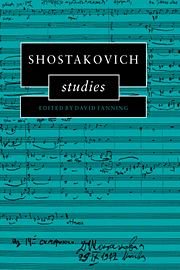Book contents
- Frontmatter
- Contents
- Acknowledgments
- 1 Introduction. Talking about eggs: musicology and Shostakovich
- 2 Public lies and unspeakable truth interpreting Shostakovich's Fifth Symphony
- 3 Form in Shostakovich's instrumental works
- 4 Russian theorists on modality in Shostakovich's music
- 5 The cycle of structure and the cycle of meaning: the Piano Trio in E minor, Op. 67
- 6 Leitmotif in Lady Macbeth
- 7 From Lady Macbeth to Katerina Shostakovich's versions and revisions
- 8 The Golden Age: the true story of the première
- 9 ‘And art made tongue-tied by authority’ Shostakovich's song-cycles
- 10 A debt repaid? Some observations on Shostakovich and his late-period recognition of Britten
- 11 Shostakovich and Schnittke: the erosion of symphonic syntax
- Index
8 - The Golden Age: the true story of the première
Published online by Cambridge University Press: 22 October 2009
- Frontmatter
- Contents
- Acknowledgments
- 1 Introduction. Talking about eggs: musicology and Shostakovich
- 2 Public lies and unspeakable truth interpreting Shostakovich's Fifth Symphony
- 3 Form in Shostakovich's instrumental works
- 4 Russian theorists on modality in Shostakovich's music
- 5 The cycle of structure and the cycle of meaning: the Piano Trio in E minor, Op. 67
- 6 Leitmotif in Lady Macbeth
- 7 From Lady Macbeth to Katerina Shostakovich's versions and revisions
- 8 The Golden Age: the true story of the première
- 9 ‘And art made tongue-tied by authority’ Shostakovich's song-cycles
- 10 A debt repaid? Some observations on Shostakovich and his late-period recognition of Britten
- 11 Shostakovich and Schnittke: the erosion of symphonic syntax
- Index
Summary
Shostakovich's three ballets – The Golden Age, Op. 22 (1929–30), The Bolt, Op. 27 (1931) and The Limpid Stream, Op. 39 (1935) – remain today, sixty years after their first appearance and twenty years after the death of the composer, among the least known works in his musical legacy.
These huge ballet scores flowed from the pen of the young genius at the time of his rapid and dazzling rise to fame. It is sufficient to recall that they appeared at the same time as The Nose and The Lady Macbeth of Mtsensk District, the First Piano Concerto and the Twenty-Four Preludes, the Cello Sonata, the early film scores (New Babylon, Alone, Golden Hills and The Passer-By (sometimes known as Counterplan)) and numerous works for the theatre. Just a single year separates The Limpid Stream from the Fourth Symphony and two years from the Fifth. This alone should be sufficient to arouse our interest in the ballets.
I shall examine here the history of the première of the first of them – The Golden Age, In doing so, the main and almost the only object of attention will be the première itself and the subsequent fate of the performance in the 1930–1 season. Not that other issues surrounding The Golden Age are unimportant. But the success or failure of a première plays no small part in the fate of a work and in the life of the composer.
- Type
- Chapter
- Information
- Shostakovich Studies , pp. 189 - 204Publisher: Cambridge University PressPrint publication year: 1995

